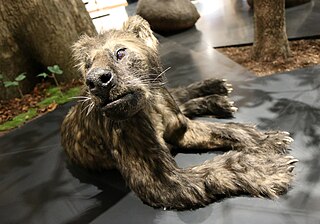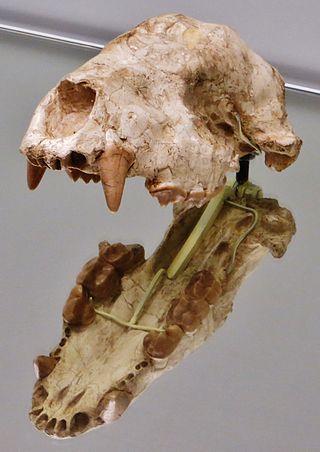
Prodeinotherium is an extinct representative of the family Deinotheriidae that lived in Africa, Europe, and Asia in the early and middle Miocene. Prodeinotherium, meaning "before terrible beast", was first named in 1930, but soon after, the only species in it, P. hungaricum, was reassigned to Deinotherium. During the 1970s, however, the two genera were once again separated, with Prodeinotherium diagnosed to include Deinotherium bavaricum, Deinotherium hobleyi, and Deinotherium pentapotamiae, which were separated based on geographic location. The three species are from Europe, Africa, and Asia, respectively. However, because of usage of few characters to separate them, only one species, P. bavaricum, or many more species, including P. cuvieri, P. orlovii, and P. sinense may be possible.

Ailuropodinae is a subfamily of Ursidae that contains only one extant species, the giant panda of China. The fossil record of this group has shown that various species of pandas were more widespread across the Holarctic, with species found in places such as Europe, much of Asia and even North America. The earliest pandas were not unlike other modern bear species in that they had an omnivorous diet but by around 2.4 million years ago, pandas have evolved to be more herbivorous.

Amphicyon is an extinct genus of large carnivorans belonging to the family Amphicyonidae, subfamily Amphicyoninae, from the Miocene epoch. Members of this family received their vernacular name for possessing bear-like and dog-like features. They ranged over North America, Europe, Asia, and Africa.

Agnotherium is a genus of large sized carnivoran mammals, belonging to the Amphicyonidae, which has been found in Western Europe, and possibly China and Northern Africa, and lived during the Late Miocene epoch. Despite only being known from fragmentary remains, the genus notable for hypercarnivorous adaptions, which have been said to represent the "apex" among its family.
Gobicyon is an extinct genus of large-sized carnivoran mammals, belonging to the Amphicyonidae, that was discovered in China, Mongolia, and Serbia, and lived during the Middle Miocene epoch. Despite only being known from rather fragmentary remains, recent discoveries showcase that it was an aberrant member of the subfamily Haplocyoninae, with adaptions towards bone-crushing similar to those of a hyaena.

Indarctos is an extinct genus of bear, endemic to North America, Europe and Asia during the Miocene. It was present from ~11.1 to 5.3 Ma, existing for approximately 6.2 million years.

Miklós Kretzoi was a Hungarian geologist, paleontologist and paleoanthropologist and Széchenyi Prize winner.
Miniopterus zapfei is a fossil bat in the genus Miniopterus from the middle Miocene of France. First described in 2002, it is known only from the site of La Grive M, where it occurs with another fossil Miniopterus species, the smaller and more common Miniopterus fossilis. M. zapfei is known from five mandibles and an isolated fourth upper premolar (P4). The fourth lower premolar is more slender than in M. fossilis and the cingulum shelf surrounding the P4 is less well-developed than in living Miniopterus. The length of the first lower molar is 1.57 to 1.60 mm.
Indraloris is a fossil primate from the Miocene of India and Pakistan in the family Sivaladapidae. Two species are now recognized: I. himalayensis from Haritalyangar, India and I. kamlialensis from the Pothohar Plateau, Pakistan. Other material from the Potwar Plateau may represent an additional, unnamed species. Body mass estimates range from about 2 kg (4.4 lb) for the smaller I. kamlialensis to over 4 kg (8.8 lb) for the larger I. himalayensis.

Anapithecus is a late Miocene primate known from fossil locations in Hungary and Austria. Many Anapithecus fossils come from the site of Rudabánya, in northern Hungary, where Anapithecus lived alongside the ape Rudapithecus. The only species in the genus, Anapithecus hernyaki, is named after Gabor Hernyák, chief geologist of the Iron Ore Works of Rudabánya.

Kretzoiarctos is an extinct bear genus from the European Miocene. It consists of Kretzoiarctos beatrix, an ancestor of the extant giant panda.

Agriotheriini is an extinct tribe of ailuropodine bears from the Middle Neogene to Early Quaternary periods with fossils found from Eurasia, Africa and North America. The tribe consists of the genera Agriotherium, Huracan, Indarctos, and possibly Miomaci. The taxonomy of these bears has variously placed some of the genera in other bear lineages such as Hemicyoninae and Ursavinae.
Rudapithecus is a chimpanzee-like genus of ape which inhabited Europe during the Late Miocene, approximately 10 million years ago. One species is known, Rudapithecus hungaricus. The genus name "Rudapithecus" comes from where it was discovered, in Rudabánya, Northern Hungary in 1965 and sent to Budapest in 1967. The specific name "hungaricus" refers to the country where it was discovered, in Hungary.

Microleo attenboroughi is a very small species of the Thylacoleonidae family of marsupials from the Early Miocene of Australia, living in the wet forest that dominated Riversleigh about 18 million years ago. The genus Microleo is currently known from a broken palate and two pieces of jaw, containing some teeth and roots that correspond to those found in other species of thylacoleonids. The shape and structure of the blade-like P3 tooth, a premolar, distinguished the species as a new genus. It was found in Early Miocene-aged deposits of the Riversleigh fossil site in Queensland, regarded as one of the most significant palaeontological sites yet discovered, and named for the naturalist David Attenborough in appreciation of his support for its heritage listing. The anatomy of Microleo suggests the genus is basal to all the known thylacoleonids, known as the marsupial lions, although its relative size prompted one discoverer to describe it as the "feisty" kitten of the family.

Canis etruscus, the Etruscan wolf, is an extinct species of canine that was endemic to Mediterranean Europe during the Early Pleistocene. The Etruscan wolf is described as a small wolf-like dog.
Ammitocyon is a genus of large sized carnivoran mammals, belonging to the Amphicyonidae, that lived during the Late Miocene in what is now Spain. It is notable for its extreme adaptations towards hypercarnivory, its extremely robust skeleton, and was one of the last surviving members of its family.
Katifelis is an extinct genus of felids that lived in what is now Kenya during the Early Miocene and is notable for its dental features, which are intermediate between basal and modern cats. It contains a single species, Katifelis nightingalei.
Myacyon is an extinct genus of large sized carnivoran mammals, belonging to the family Amphicyonidae, that lived in Africa during the Miocene epoch. Due to the limited scope and fragmentary nature of the severely damaged holotype, as well as the illustrations in its descriptions, which have been called inadequate, usage of this genus poses serious issues. However, it is notable for being one of the last surviving members of its family and its adaptions to hypercarnivory. Its relationships to other amphicyonids are obscure, and it is not closely related to Bonisicyon, the other late surviving African genus, although it has been proposed that it descends from a species of Cynelos or Namibiocyon.
Bonisicyon is an extinct genus of carnivoran mammals, belonging to the family Amphicyonidae. It is the last-surviving member of its family, living in East Africa during the end of the Miocene epoch. Known only from a damaged mandible and isolated teeth from the Nawata Formation, and possibly also the Lukeino Formation, its closer taxonomic affinities are unclear. It is notable for both its small size, and its unique dentition.
Namibiocyon is an extinct genus of carnivoran mammals, belonging to the family Amphicyonidae, that lived in Namibia during the Early Miocene epoch. Before the erection of this taxon in 2022, the type and only species, N. ginsburgi, had been assigned to a variety of other genera. It is notable for its adaptions toward hypercarnivory.










